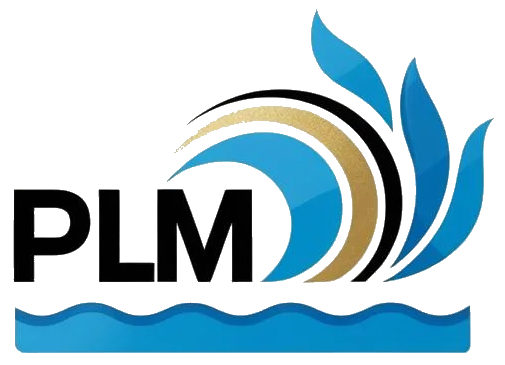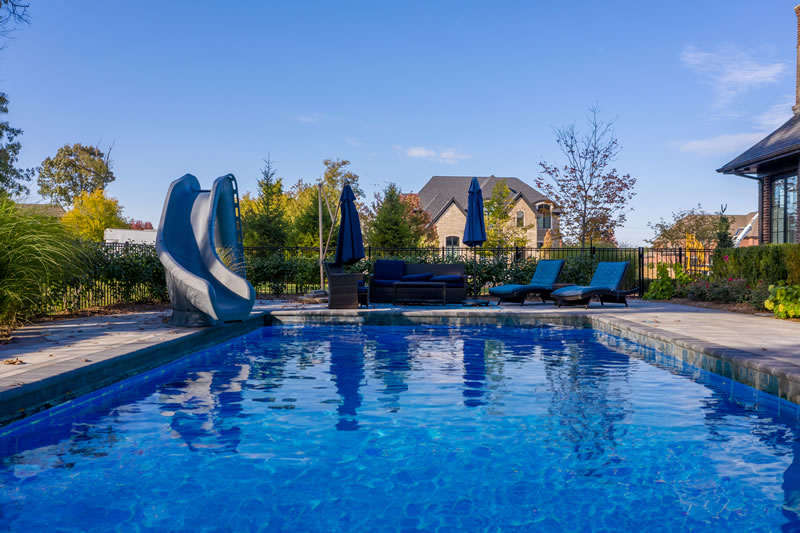Designing Your Swimming Pool in Oakland County
Building a custom swimming pool at your Oakland County residence is more than an upgrade; it’s a personal statement and lifestyle investment. Unfortunately, however, the excitement of selecting intricate designs, sparkling tiles, and elegant water features often overshadows any practicalities required to ensure it will be rewarding rather than cumbersome – which is why we have put together seven essential considerations that will guide the design of your aquatic oasis without stressing over each detail of its creation.
At every planning stage, we assess every facet: from creating an adequate budget, accommodating local weather conditions, understanding long-term costs, and understanding insurance implications to energy efficiency measures and eco-friendly solutions, not to mention local building codes. Each element is integral in helping create a swimming pool that fulfills aesthetic preferences and fits within your budget, climate conditions, and sustainability objectives.
Join Profitable Landscape Marketingas we cover these practical elements of custom pool installation to prepare you for this exciting adventure with Oakland County’s premiere luxury custom pool contractor! Let’s dive right in!
Designing a custom pool in Oakland County is a fun and exciting experience; there are so many design decisions that you may forget to consider the practical components. Here are seven considerations to make when you are in the design process of your custom pool. These will ensure a fantastic pool that works with your yard and budget.
1. Establishing a Budget
Beginning the journey of designing your dream pool can be exciting, yet setting a budget can dampen some of that enthusiasm. But creating an established budget remains one of the critical steps in this process.
As with any substantial investment, creating a swimming pool requires significant financial commitment; knowing what’s within your comfort spending range is vital to its success. Without a clear financial plan, costs may become overwhelming rather than enjoyable; constant worry over expenses could hinder the intended enjoyment in your home.
Before beginning the design process, discussing your budget openly with a custom pool builder is advisable. This serves multiple purposes. First and foremost, it ensures you and your pool builder are working towards the same goal while preventing future miscommunications or potential misunderstandings between you. In addition, your budget acts as a financial compass that guides design decisions, material choices, and feature selections during a project.
An open dialogue regarding budget allows your pool builder to provide realistic options matching your financial capabilities, creating a design that won’t compromise either vision or wallet. Your builder can also assist in exploring options, prioritizing features, and devising plans to extract maximum value from every dollar spent.
Establishing a budget doesn’t mean restricting your dreams; instead, it means turning those dreams into realities that meet aesthetic and financial considerations. While budget planning might not be the most exciting aspect of pool design, establishing one remains essential in creating an enjoyable ownership experience for pool ownership.
2. Consider the Weather in Oakland County
As you begin designing your custom swimming pool, one essential consideration should be your location’s climate and weather patterns. In Oakland County, Michigan, for instance, the four-season climate includes warm summers, colorful autumns, cold winters, and blossoming springs – each having different effects on a pool’s design, usability, and functionality.
At our latitudes, where four seasons coexist simultaneously, designing your pool to adapt and respond appropriately is paramount. One effective solution for doing so is installing an enclosure around it; there are various styles from fully enclosed structures to retractable ones, that protect from rain, snow, and leaves while also creating an enjoyable swimming environment even on chillier autumn or spring days.
Michigan’s unpredictable summers necessitate installing a heating system for your pool. While Michigan summers may be hot, cooler spells could make swimming less appealing; having a pool heater keeps water at an ideal temperature all year, so swimming remains possible no matter the climate!
Heaters also extend your swimming season, enabling you to start early when temperatures are still relatively mild and continue swimming comfortably into autumn, all while enjoying comfortable water temperatures.
Weather considerations when designing your pool go far beyond accommodating Michigan’s climate; they allow you to tailor it to your environment for maximum comfort, usability, and enjoyment year-round. When sketching your dream pool plan, be sure to factor in our varied weather – doing so will guarantee it remains enjoyable no matter the forecast!
3. Think about Long-Term Costs
While initial excitement about designing and building a swimming pool may center around upfront costs, the long-term costs of owning one should also be considered to ensure that it remains a source of enjoyment rather than becoming an additional financial strain. Understanding these expenses is crucial to making your dream pool an enjoyable investment and preventing it from becoming a burdensome financial obligation.
Maintaining a swimming pool goes beyond construction; regular upkeep is required to keep it safe, clean, and operating efficiently. Maintenance costs can include routine cleaning, chemical balance testing, filter replacements, potential repairs, and more – although these might initially seem expensive. With careful planning and the appropriate strategies, maintaining your pool won’t break the bank!
Energy-efficient options are an ideal way to cut running costs while protecting the environment. Modern pool systems increasingly prioritize efficiency and sustainability. Energy-efficient pool pumps, heaters, and lighting can substantially lower power usage – thus cutting operating costs significantly – while using a pool cover will retain heat, reduce water evaporation, and keep debris at bay, further saving costs for heating, watering, and cleaning expenses.
A pool’s capacity to hold water is another essential consideration. Filling and maintaining its level can become costly in hot summer months; investing in an efficient design with water-saving features (such as installing a cover) could reduce this expense significantly.
Not to forget the additional accessories you may wish to add to your pool – such as aesthetic features such as waterfalls or deck jets, functional equipment like robotic cleaners or salt chlorine generators, and safety measures like pool fencing or alarms; though these extra features may add costs they can also enrich both experience and value of swimming in your pool.
Planned pool ownership means taking an objective view and considering all the costs accompanying ownership over time. Understanding these expenses and creating strategies to control them, your pool should remain an enjoyable retreat for years.
4. Don’t Forget About Insurance
Planning and building a swimming pool is a multi-faceted process beyond design decisions and construction details. An often overlooked but critical consideration in this process is insurance. As you take steps toward creating your backyard oasis, it’s essential to understand how owning a pool can affect your existing homeowner’s insurance policy.
Owning a swimming pool can potentially increase the liability risk on your property. It’s often viewed as an “attractive nuisance” by insurance companies, which means it could attract people, especially children, who might hurt themselves. Consequently, having a pool on your property may impact your homeowner’s insurance policy, usually resulting in a need for increased liability coverage.
Make it a priority to contact your insurance provider and discuss how adding a pool will affect your policy. Some companies may require additional liability protection, typically recommended at a minimum of $100,000. You might even consider increasing this amount depending on the provider and your specific circumstances.
Furthermore, your Michigan insurance provider may have specific safety requirements, such as installing a particular type of pool fence, a self-latching gate, or pool alarms to help prevent accidents. Non-compliance with these conditions could affect your policy or claims.
It’s also worth considering coverage for the pool itself. Damage to or loss of the pool due to weather conditions, accidental damage, or even pool equipment failure might be things you want to cover. Each policy is different, so it’s crucial to understand what is and isn’t included.
While it might seem like a tedious step amidst the excitement of designing your dream pool, addressing insurance considerations upfront can save you from future headaches. Ensuring you have proper coverage will allow you to fully enjoy your pool with the peace of mind that you’re adequately protected. It’s all about making your pool a long-term source of joy, relaxation, and fun without any unwelcome surprises.
5. Be Energy Efficient
At a time when environmental and financial considerations are equally paramount, choosing energy-efficient products for your swimming pool is a wise decision. Utilizing energy-saving measures contributes to protecting our planet and offers significant savings on operating costs.
Installing an enclosure cover is an effective strategy to increase energy efficiency in your pool. Pool covers help minimize evaporation, thus decreasing heating and refilling energy costs and keeping your pool cleaner, decreasing demands on filtration and cleaning systems.
Selecting an efficient pool pump can also result in significant energy savings. Traditional pool pumps tend to operate at one speed that’s too high for most functions; in contrast, variable-speed pumps can adjust their speed according to the task at hand, thus using less energy during activities like filtration, for example, and thus saving both energy and costs over time.
Lighting is another area where intelligent choices can reduce energy use. LED pool lights use much less electricity than their incandescent and halogen counterparts and have much longer lives; when combined with timers or motion sensors, their use further cuts energy usage.
Others to keep in mind include installing a solar heater to utilize solar energy for pool heating purposes or an alternative energy pool pump with solar capabilities, which will help decrease your pool’s dependence on traditional energy sources such as gasoline or electricity.
Being energy efficient with your pool doesn’t require making substantial sacrifices to comfort or usability; with careful planning and making wise choices, it’s possible to craft an experience that is both enjoyable and environmentally responsible – plus, the savings on energy bills make energy efficiency a win-win scenario for both you and the planet!
6. Think Eco-Friendly
Designing a swimming pool with ecological responsibility in mind is an admirable goal, and with various eco-friendly options now available, it’s achievable without compromising comfort or style.
Solar-powered pool equipment is an excellent way to reduce energy use. Solar heaters harness the sun’s abundant renewable energy source to warm your pool, significantly decreasing your reliance on non-renewable sources like fossil fuels. Solar lights also offer efficient illumination without adding costs. Finally, solar-powered pool pumps operate without drawing power from the grid, leading to considerable energy savings.
Your pool filtration system provides another opportunity to make environmentally-friendly choices. Traditional pool filters may require backwashing, which wastes significant water; newer cartridge filters allow cleaning without backwashing for considerable water savings; natural pool filters use biologically active substances instead to filter water – another eco-friendly choice!
Selecting eco-friendly chemicals for your pool can make an enormous difference. Traditional pool chemicals may adversely impact swimmers and the environment and cause skin or eye irritation for aquatic enthusiasts. By opting for eco-friendly alternatives like saltwater systems, UV sanitation systems, and mineral purifiers – which all reduce environmental footprint – instead, your pool will remain safe while at the same time remaining clean and safe!
Consider landscaping around your pool as well. Planting native, drought-resistant species will lower water usage, while porous materials used for decking will minimize runoff while replenishing groundwater supplies.
Adopting eco-friendly pool designs is not only good for the planet; it can also bring personal advantages. Lower operational costs, a healthier swimming environment, and peace of mind knowing you are helping promote a sustainable future are just some of the rewards of doing your part to support a greener tomorrow with intelligent planning and choices that align with environmental stewardship—enjoying luxury with a reduced ecological footprint.
7. Check Your Local Building Codes
Designing and installing a custom swimming pool requires more than choosing its shape, size, and aesthetics; it also involves understanding and complying with the local legal and regulatory landscape. Building codes, zoning laws, and homeowner association rules all play an integral part in determining where, how, and what can be built.
Safety is of primary concern in many local regulations, with one of the most prevalent being fencing around your pool as required to prevent accidental access by children and often specifying requirements such as fence height and type, gate mechanisms, and locks types; some jurisdictions also mandate pool alarms as additional safety equipment.
Building permits are often necessary when installing a swimming pool, with the process for obtaining one differing depending on your area. Submitting plans and scheduling inspections at various stages is usually required to secure one; working with a knowledgeable builder who understands local requirements can be invaluable in keeping your project on schedule.
Additional restrictions could include regulations regarding noise during construction or operation, setbacks from property lines or buildings, restrictions on equipment placement, and lighting rules for your pool. In some instances, installing a pool may also affect property taxes, something to remember when budgeting.
As part of the Homeowners Association (HOA), it’s also important to read over its rules regarding pool construction. These may cover size, location, aesthetics, noise considerations, and whether approval from your HOA is required before beginning.
As daunting as this list may appear, remember that these regulations exist to safeguard you and your community. Understanding and abiding by local building codes is an integral part of designing a pool – doing your due diligence here can ensure not only legality and safety for both you and your pool construction project but also reduce delays by eliminating costly mistakes along the way – for a smooth, successful project experience.
Designing Your Custom Swimming Pool in Oakland County
Building your ideal swimming pool can be one of the most exciting projects you’ll undertake, and selecting design elements, visualizing their layout, and finally seeing it come together can bring great satisfaction. However, it is essential to remember that successful pool design must balance aesthetics with practicality: Your design must capture attention and serve your budget, budget constraints, and the local community in Oakland County effectively.
A well-designed pool should fit seamlessly with your lifestyle, preferences, and needs. From creating an oasis of tranquility for relaxation to hosting rigorous swimming sessions or gatherings with family and friends – your pool should serve its intended purpose effectively and be seamlessly integrated with both its architecture and natural features to form an outdoor living space that works.
Financial considerations play a pivotal role in pool design. From initial construction and long-term maintenance expenses to energy efficiency requirements, and insurance implications, your pool must conform to your financial realities for the best results. Designing a sustainable feature that you can comfortably maintain over time.
Your pool design must adhere to local regulations and environmental conditions in Oakland County. Adherence to local building codes, climate considerations, and eco-friendly practices fulfills legal obligations and is an obligation towards your community and the environment at large.
Designing a custom swimming pool requires an intricate dance between dream and reality, form and function, individual desire, and community responsibility. Once all these factors have been carefully considered and balanced out properly, you’ll end up with a pool you not only love designing but will love owning and using for years. Your custom pool should reflect who you are while becoming part of your home for many years to come.
Contact Profitable Landscape Marketingto start designing your custom swimming pool. Sapphire Landscaping is an Oakland County luxury custom pool contractor. Call today: 248-525-1700.


